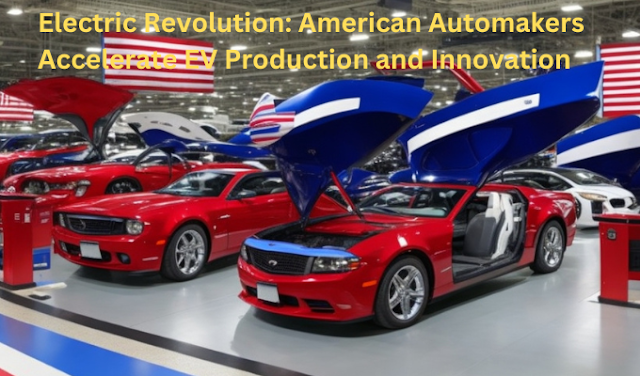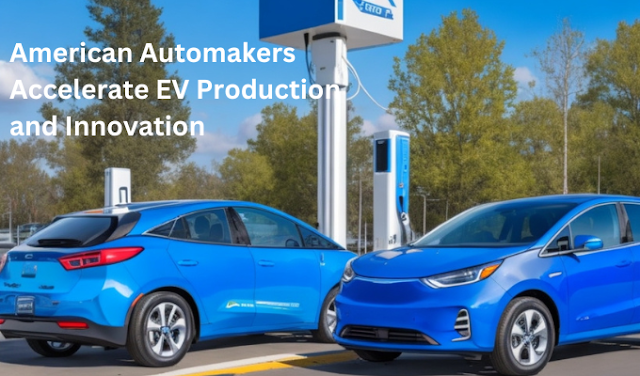Electric Revolution: American Automakers Accelerate EV Production and Innovation
The automotive industry is undergoing a significant transformation as the world shifts towards a more sustainable future. In recent years, there has been a remarkable surge in the production and innovation of electric vehicles (EVs).
American automakers, in particular, have taken center stage in this electric revolution. With a renewed focus on sustainability and technological advancements, American automakers are leading the charge in accelerating EV production and driving innovation. This article explores the efforts and achievements of American automakers in the electric revolution.
Table of Contents
1. The Rise of Electric Vehicles
2. American Automakers Embrace Electric Revolution
1. General Motors: A Bold Commitment to EVs
2. Ford: The Mustang Mach-E and Beyond
3. Tesla: Pioneering the Electric Revolution
3. Advancements in Electric Vehicle Technology
1. Extended Range and Fast Charging
2. Enhanced Safety Features
3. Connectivity and Autonomous Capabilities
4. Overcoming Challenges in EV Adoption
1. Expanding Charging Infrastructure
2. Affordability and Accessibility
3. Range Anxiety and Education
5. Government Support and Policy Changes
6. Environmental Benefits of Electric Vehicles
7. Conclusion
8. FAQs (Frequently Asked Questions)
1. The Rise of Electric Vehicles
Over the past decade, the global automotive landscape has witnessed a remarkable rise in the popularity of electric vehicles. EVs offer several advantages over traditional gasoline-powered cars, including lower emissions, reduced reliance on fossil fuels, and quieter operation. As concerns about climate change and environmental sustainability have grown, consumers are increasingly turning to electric vehicles as a viable alternative.
2. American Automakers Embrace Electric Revolution
2.1 General Motors: A Bold Commitment to EVs
General Motors (GM), one of the most prominent American automakers, has made a bold commitment to an all-electric future. The company plans to invest heavily in electric vehicle production, to achieve zero emissions by 2035. GM's flagship electric vehicle, the Chevrolet Bolt EV, has gained popularity for its impressive range and affordability. The company is also set to introduce several new electric models, including the GMC Hummer EV and Cadillac Lyriq, showcasing its dedication to driving the electric revolution.
2.2 Ford: The Mustang Mach-E and Beyond
Ford, another American automotive giant, has embraced the electric revolution with its introduction of the Mustang Mach-E. This all-electric SUV combines the iconic Mustang brand with cutting-edge EV technology, appealing to both performance enthusiasts and environmentally conscious consumers.
Ford has committed significant resources to expand its electric vehicle lineup, with plans to introduce electric versions of popular models like the F-150 and Transit van. By doing so, Ford aims to make electric vehicles accessible to a wider range of consumers.
2.3 Tesla: Pioneering the Electric Revolution
No discussion about American automakers and electric vehicles would be complete without mentioning Tesla. Tesla has played a pivotal role in popularizing electric vehicles and driving innovation in the industry.
With its groundbreaking models like the Model S, Model 3, and Model X, Tesla has pushed the boundaries of electric vehicle technology. The company's Supercharger network has addressed one of the primary concerns surrounding EVs—the availability of charging infrastructure. Tesla continues to lead the electric revolution by focusing on long-range capabilities, autonomous driving, and energy efficiency.
3. Advancements in Electric Vehicle Technology
As electric vehicles have gained momentum, significant advancements in technology have propelled the electric revolution forward. These advancements have addressed key concerns regarding range, charging infrastructure, safety, and overall user experience.
3.1 Extended Range and Fast Charging
One of the primary concerns for potential EV buyers has been the limited range of electric vehicles compared to traditional gasoline-powered cars. However, technological innovations have led to significant improvements in battery capacity and efficiency, resulting in extended driving ranges. Modern electric vehicles can now travel hundreds of miles on a single charge, alleviating range anxiety.
Furthermore, fast-charging technologies have emerged, allowing EV owners to recharge their vehicles quickly. Fast-charging stations, equipped with high-power charging infrastructure, can replenish a significant portion of an EV's battery capacity in a matter of minutes. This convenience has made electric vehicles more practical and appealing to a broader audience.
3.2 Enhanced Safety Features
Automakers have prioritized safety in the development of electric vehicles. In many cases, EVs come equipped with advanced safety features that are on par with or even surpass those found in traditional cars. Electric vehicles often have robust structural designs, high-strength materials, and strategically placed battery packs that contribute to enhanced safety during collisions.
Additionally, EVs benefit from lower centers of gravity due to their battery placement, reducing the risk of rollovers. Advanced driver-assistance systems (ADAS), such as collision warning systems, lane-keeping assist, and adaptive cruise control, further enhance the safety aspect of electric vehicles. These features not only protect occupants but also contribute to overall road safety.
3.3 Connectivity and Autonomous Capabilities
Electric vehicles are at the forefront of connectivity and autonomous driving technology. Many EVs offer advanced infotainment systems with seamless integration of smartphones, allowing drivers to access navigation, music, and other apps effortlessly. Moreover, electric vehicles are often equipped with over-the-air software updates, enabling continuous improvements and adding new features over time.
Furthermore, the electric revolution has paved the way for advancements in autonomous driving technology. Electric vehicles frequently serve as platforms for testing and implementing autonomous features, such as lane-keeping assistance, self-parking, and even advanced autopilot capabilities. These innovations not only enhance convenience but also have the potential to improve road safety and reduce traffic congestion in the future.
4. Overcoming Challenges in EV Adoption
While electric vehicles offer numerous benefits, several challenges need to be addressed to accelerate their adoption and make them accessible to a wider audience.
4.1 Expanding Charging Infrastructure
One of the critical challenges for electric vehicle adoption is the availability and accessibility of charging infrastructure. To encourage the widespread use of EVs, it is crucial to develop an extensive network of charging stations that are conveniently located and offer fast-charging capabilities. Governments, automakers, and private entities are investing in the expansion of charging infrastructure to meet the growing demand for electric vehicles.
4.2 Affordability and Accessibility
Affordability remains a significant barrier to EV adoption. While the cost of electric vehicles has decreased over the years, they still tend to have a higher upfront price compared to their gasoline-powered counterparts.
However, advancements in battery technology and economies of scale in production are gradually driving down the costs of electric vehicles. Additionally, government incentives and subsidies are being implemented to make EVs more affordable for consumers.
Ensuring accessibility to electric vehicles is equally important. Automakers are expanding their electric vehicle portfolios to include a range of models, from affordable compact cars to high-end luxury vehicles. This diversification allows consumers with varying budgets to choose an electric vehicle that suits their needs.
4.3 Range Anxiety and Education
Range anxiety, the fear of running out of battery power during a journey, has been a concern for potential EV buyers. However, advancements in battery technology and the expansion of charging infrastructure are gradually alleviating this anxiety. With improved battery ranges and the growing availability of charging stations, drivers can confidently plan their journeys, knowing that recharging options are readily accessible.
Moreover, education plays a vital role in addressing range anxiety. Educating consumers about the capabilities of electric vehicles, charging options, and the benefits of electric mobility can help dispel misconceptions and build confidence in EV ownership. By providing accurate information and raising awareness about the practicality and advantages of electric vehicles, more people can overcome range anxiety and embrace the electric revolution.
5. Government Support and Policy Changes
Government support and policy changes have played a crucial role in accelerating the adoption of electric vehicles. Many governments around the world have implemented incentives and subsidies to promote EV purchases, such as tax credits, grants, and rebates. These financial incentives help reduce the initial cost barrier and make electric vehicles more affordable for consumers.
Additionally, governments are investing in the development of charging infrastructure and offering incentives for the installation of charging stations. This infrastructure expansion enables convenient charging options and encourages EV adoption, particularly in residential areas, workplaces, and public spaces.
Furthermore, stricter emissions regulations and mandates have pushed automakers to prioritize electric vehicle production. Government policies that encourage a shift towards sustainable transportation are driving innovation and compelling automakers to invest in electric vehicle technology and manufacturing capabilities.
6. Environmental Benefits of Electric Vehicles
The environmental benefits of electric vehicles are significant and contribute to a greener and more sustainable future. Electric vehicles produce zero tailpipe emissions, reducing air pollution and combating climate change. By replacing internal combustion engines with electric motors, EVs help decrease greenhouse gas emissions and improve air quality, resulting in healthier living environments for communities.
Furthermore, electric vehicles play a crucial role in the integration of renewable energy sources. With smart charging solutions and vehicle-to-grid technology, electric vehicles can act as mobile energy storage, helping balance the electricity grid and maximizing the utilization of renewable energy. This synergy between electric vehicles and renewable energy sources paves the way for a more sustainable and resilient energy system.
Conclusion
The electric revolution is rapidly transforming the automotive industry, and American automakers are at the forefront of this transformative journey. With their commitment to EV production and innovation, American automakers such as General Motors, Ford, and Tesla are driving the electric revolution forward. Advancements in technology, such as extended ranges, fast-charging capabilities, enhanced safety features, and connectivity, have made electric vehicles more appealing and practical for consumers.
However, challenges remain, including expanding charging infrastructure, ensuring affordability and accessibility, addressing range anxiety, and promoting education about electric vehicles. Government support and policy changes have played a significant role in overcoming these challenges and fostering the widespread adoption of electric vehicles. The environmental benefits of EVs, including reduced emissions and the integration of renewable energy, further reinforce the importance of the electric revolution for a sustainable future.
FAQs (Frequently Asked Questions)
1. Are electric vehicles more expensive than gasoline-powered cars?
- While electric vehicles may have a higher upfront cost, factors such as lower operating and maintenance costs, tax incentives, and fuel savings over time can offset the initial investment.
2. How far can electric vehicles travel on a single charge?
- The range of electric vehicles varies depending on the model and battery capacity. Modern EVs can typically travel between 150 to 300 miles on a single charge, with some models exceeding 400 miles.
3. Is charging infrastructure widely available?
- The availability of charging infrastructure for electric vehicles is continually improving. While it may not be as widespread as traditional gasoline stations, charging stations can be found in various locations, including public spaces, shopping centers, workplaces, and along highways. Many governments and private companies are investing in the expansion of charging networks to meet the growing demand for electric vehicles. Additionally, advancements in fast-charging technology have made recharging more convenient and efficient, reducing charging times significantly. As the electric revolution progresses, the accessibility of charging infrastructure will continue to increase, further supporting the widespread adoption of electric vehicles.




